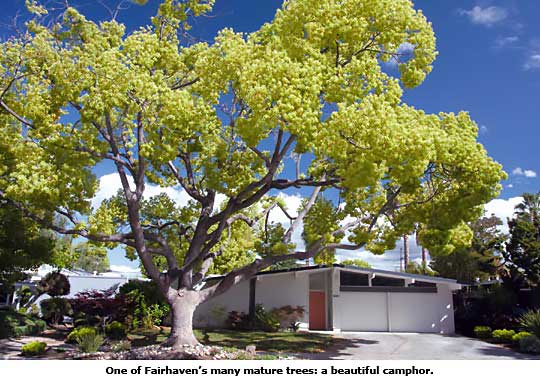Family-First Fairhaven - San Jose
 Not everything was sweetness and light when Erica and Steve Dreyer moved from San Francisco to a small enclave of Eichler homes in San Jose that is so obscure even most of the inhabitants have forgotten the tract's original name.
Not everything was sweetness and light when Erica and Steve Dreyer moved from San Francisco to a small enclave of Eichler homes in San Jose that is so obscure even most of the inhabitants have forgotten the tract's original name.
The Dreyers, who were expecting their first child, planned to renovate their new home, which clearly needed it. "Somebody said, 'Don't buy any tools. Somebody else in the neighborhood will have it and lend it to you,'" Steve recalls. The couple had already begun ripping apart the kitchen on their first night in the house, so a restaurant eat-out was expected. Instead, their next-door neighbor invited them for dinner.
Today that neighbor, Lyn Rowland, is a close friend and their son's "surrogate grandmother," Erica says. "We were surprised how friendly people were," she adds.
There were several initial encounters, however, that while friendly had an edge to them. "When people saw us working on the house," Steve says, "they came by to see if we planned any major additions." When the Dreyers answered "no," relief was clear.

Fairhaven, though small, is remarkable both for its sense of community and its architectural integrity. Except for one home that, while retaining its Eichler lines, was given a brick façade, one flat-roofed model that got an added room, and the most recent unsympathetic change, a small bay window to a third house, the neighborhood "looks exactly like it has my whole life," says Ivy Chesser, who was born In Fairhaven in 1971 and moved back seven years ago.
"Fifty-seven families," Mike Ahern brags about his neighborhood, "and they all love their Eichlers."
"We're like the hidden jewel," Ivy says of her neighborhood, and her husband Kyle chimes in: "because not a lot of people know we exist."

Or even what the neighborhood is called. 'Fairhaven,' the original name, is known today only by old-timers and folks who peruse the original plans. Most people, if they call the place anything, call it 'Mossbrook' after two of its three streets.
Built in 1961 and 1962 on a former plum orchard, Fairhaven features three different Eichler models, designed by the architectural firms of Claude Oakland and Jones & Emmons. Two of the models have low gables and an atrium; a third has a flat roof and no atrium. Most are 1,750 square feet, plus atrium. Rowland, an original buyer, paid $26,000 for her home. Homes with larger lots in the center of the circle went for $500 to $1,000 more.

What really makes the 48-year-old neighborhood special is less architectural than social preservation. Person after person in the neighborhood, even the kids, describes it as an extended family, a place where people know their neighbors well.
"Pete and Lisa [Ford] next door are like an aunt and uncle," says Jacob Cassell, Ivy Chesser's son. Residents tend to stay. There are about nine original owners, and many more who have been there for 30 or more years. Even when people leave, they don't really leave. "They come back for the birthings, marriages, and burying," says Susan Robbins, a resident since 1975.

"I thought of moving," long-timer Ann Thompson says, "but the kids said, 'You can't do that, because when we come home we want to see 'our whole family.' That's the way they put it."
"Eighteen months after we moved in, we know everyone," says newcomer Nate Johnson, who's raising a daughter with his wife Paige. "We call it Pleasantville."
The layout certainly contributes to its neighborliness—as does the neighborhood's size, which makes it possible for the socially adept to know almost everyone. In the evening, many people stroll, often pushing perambulators filled with babies—or even their pets. "It's like an enclosed village," Rowland says of Fairhaven. "I really believe that's why it attracts people."
"I think it's the attitude, the spirit of the place," Robbins says. "People are determined to care for each other."




